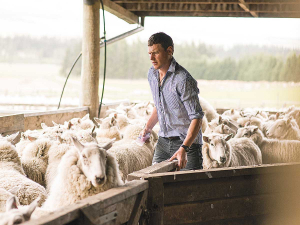Getting sheep shape at Pyramid Farm
The vineyards at Pyramid Farm in Marlborough’s Avon Valley have never been run of the mill, with plantings that follow the natural contours of the land, 250 metres above sea level.
 Farmers have the next few weeks to lift the condition of their lighter ewes before the ram goes out. Photo: Kieran Scott.
Farmers have the next few weeks to lift the condition of their lighter ewes before the ram goes out. Photo: Kieran Scott.
Sheep farmers in many parts of the country have the next few weeks to lift the condition of their lighter ewes before the ram goes out.
Body Condition Scoring (BCS) pre-tupping allows farmers to identify any ewes that fall outside the optimum BCS 3-4. These can be then managed strategically to either lift or reduce body condition.
This could include running lighter-conditioned ewes on priority pasture or forage crops and/or supplementary feeding.
Numerous studies have shown that ewes with a BCS of 3-4 at lambing give birth to heavier lambs, are better mothers, have more milk and wean heavier lambs with a higher survival rate.
To determine the body condition score, place a hand behind the ewe's 13th rib. Using of the balls of the fingers and thumbs, feel the backbone with the thumb and end of the short ribs with the finger tips behind the last rib.
Feel the muscle and fat cover around the end of the short ribs and backbone.
So, what does BCS3& feel like?
The vertical processes are smooth and rounded; the bone is only felt with pressure. The horizontal processes are also smooth and well-covered; hard pressure with the fingers is needed to find the ends. The loin muscle is full, with a moderate fat cover.
The actual numbers are not as important as consistency, so it is preferable for just one or two people to be doing the scoring.
More information about Body Condition Scoring: https://beeflambnz.com/search?term=Body+Condition+Scoring
A New Zealand dairy industry leader believes the free trade deal announced with India delivers wins for the sector.
The Coalition Government will need the support of at least one opposition party to ratify the free trade deal with India.
Primary sector leaders have welcomed the announcement of a Free Trade Agreement between India and New Zealand.
At Pāmu’s Kepler Farm in Manapouri, mating has wrapped up at the across-breed Beef Progeny Test.
More than 150 people turned up at Parliament recently to celebrate the 20th anniversary of Horticulture New Zealand (HortNZ).
Biosecurity New Zealand says Kiwis should continue to keep an eye out for yellow-legged hornets (Vespa velutina) over the holiday season.

OPINION: The release of the Natural Environment Bill and Planning Bill to replace the Resource Management Act is a red-letter day…
OPINION: Federated Farmers has launched a new campaign, swapping ‘The Twelve Days of Christmas’ for ‘The Twelve Pests of Christmas’ to…